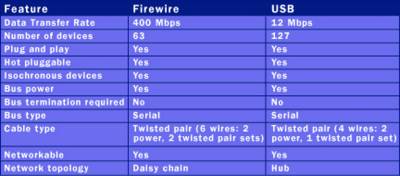How FireWire Works
You have probably heard the term FireWire if you have any interest in digital video. FireWire is essentially a new way to connect different pieces of equipment so they can easily and quickly share information.
Background
FireWire, originally created by Apple and standardized in 1995 as the specification IEEE-1394 High Performance Serial Bus, is very similar to Universal Serial Bus (USB). The designers of FireWire, which actually precedes the development of USB, had several particular goals in mind when they created the standard:
- Fast transfer of data (up to 400 Mbps)
- Lots of devices on the bus
- Ease of use
- Hot pluggable
- Provide power through the cable
- Plug-and-play
- Low cabling cost
- Low implementation cost
FireWire Basics
When the host computer powers up, it queries all of the devices connected to the bus and assigns each one an address, a process called enumeration. FireWire is plug-and-play, so if a new FireWire device is connected to a computer, the operating system auto-detects it and asks for the driver disk. If the device has already been installed, the computer activates it and starts talking to it. FireWire devices are hot pluggable, which means they can be connected and disconnected at any time, even with the power on.
FireWire uses 64-bit fixed addressing, based on the IEEE 1212 standard. There are three parts to each packet of information sent by a device over FireWire:
- A 10-bit bus ID that is used to determine which FireWire bus the data came from
- A 6-bit physical ID that identifies which device on the bus sent the data
- A 48-bit storage area that is capable of addressing 256 terabytes of information for each node!
The bus ID and physical ID together comprise the 16-bit node ID, which allows for 64,000 nodes on a system. Individual FireWire cables can run as long as 4.5 meters. Data can be sent through up to 16 hops for a total maximum distance of 72 meters. Hops occur when devices are daisy-chained together. Look at the example below. The camcorder is connected to the external hard drive connected to Computer A. Computer A is connected to Computer B, which in turn is connected to Computer C. It takes four hops for Computer C to access the camera.

FireWire devices can be powered or unpowered. FireWire allows devices to draw their power from their connection. Two power conductors in the cable can supply power (8 to 40 volts, 1.5 amps maximum) from the computer to an unpowered device. Obviously, a high-power device like an external hard drive will have its own power supply, but low-power devices like digital still cameras can get their power from the bus in order to simplify them. Two twisted pair sets carry the data in a FireWire cable.

In the next section, we'll discuss the differences between FireWire and USB.
FireWire vs. USB
The key difference between FireWire and USB is that FireWire is intended for devices working with a lot more data -- things like camcorders, DVD players and digital audio equipment. FireWire and USB share a number of characteristics and differ in some important ways.
Here's a summary:
As you can see, the two are remarkably alike. Implementing FireWire costs a little more than USB, which led to the adoption of USB as the standard for connecting most peripherals that do not require a high-speed bus.
USB 2.0, released in 2001 and becoming popular in 2002, is designed to offer performance similar to FireWire. USB 2.0 has a maximum data rate of 480 Mbps. Given that their speeds are now roughly identical, the big difference remaining between FireWire and USB 2.0 is that USB 2.0 is host-based, meaning that devices must connect to a computer in order to communicate. FireWire is peer-to-peer, meaning that two FireWire cameras can talk to each other without going through a computer.
Digital Video
FireWire really shines when it comes to digital video applications. Most digital video cameras or camcorders now have a FireWire plug. When you attach a camcorder to a computer using FireWire, the connection is amazing!

An important element of FireWire is the support of isochronous devices. In isochronous mode, data streams between the device and the host in real-time with guaranteed bandwidth and no error correction. Essentially, this means that a device like a digital camcorder can request that the host computer allocate enough bandwidth for the camcorder to send uncompressed video in real-time to the computer. When the computer/camera FireWire connection enters isochronous mode, the camera can send the video in a steady flow to the computer without anything disrupting the process.
You can easily edit and create custom video projects using fast hard drives, a digital camcorder and a computer. With the right software, the computer and the camera communicate, and the computer can download all of the video automatically and with perfect digital clarity. Since the content is digital from start to finish, there is no loss of quality as you work on successive generations.




1 Comments:
More please ;-)
Post a Comment
<< Home